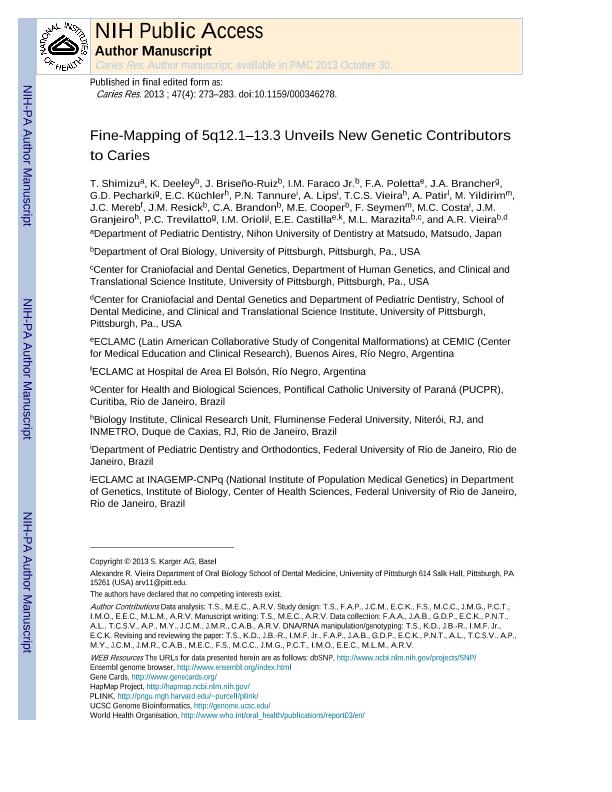Artículo
Fine-mapping of 5q12.1-13.3 unveils new genetic contributors to caries
Shimizu, T.; Deeley, K.; Briseño Ruiz, J.; Faraco Junior, I. M.; Poletta, Fernando Adrián ; Brancher, J. A.; Pecharki, G. D.; Küchler, E. C.; Tannure, P. N.; Lips, A.; Vieira, T. C. S.; Patir, A.; Yildirim, M.; Mereb, J. C.; Resick, J. M.; Brandon, C. A.; Cooper, M. E.; Seymen, F.; Costa, M. C.; Granjeiro, J. M.; Trevilatto, P. C.; Orioli, I. M.; Castilla, Eduardo Enrique
; Brancher, J. A.; Pecharki, G. D.; Küchler, E. C.; Tannure, P. N.; Lips, A.; Vieira, T. C. S.; Patir, A.; Yildirim, M.; Mereb, J. C.; Resick, J. M.; Brandon, C. A.; Cooper, M. E.; Seymen, F.; Costa, M. C.; Granjeiro, J. M.; Trevilatto, P. C.; Orioli, I. M.; Castilla, Eduardo Enrique ; Marazita, M. L.; Vieira, A. R.
; Marazita, M. L.; Vieira, A. R.
 ; Brancher, J. A.; Pecharki, G. D.; Küchler, E. C.; Tannure, P. N.; Lips, A.; Vieira, T. C. S.; Patir, A.; Yildirim, M.; Mereb, J. C.; Resick, J. M.; Brandon, C. A.; Cooper, M. E.; Seymen, F.; Costa, M. C.; Granjeiro, J. M.; Trevilatto, P. C.; Orioli, I. M.; Castilla, Eduardo Enrique
; Brancher, J. A.; Pecharki, G. D.; Küchler, E. C.; Tannure, P. N.; Lips, A.; Vieira, T. C. S.; Patir, A.; Yildirim, M.; Mereb, J. C.; Resick, J. M.; Brandon, C. A.; Cooper, M. E.; Seymen, F.; Costa, M. C.; Granjeiro, J. M.; Trevilatto, P. C.; Orioli, I. M.; Castilla, Eduardo Enrique ; Marazita, M. L.; Vieira, A. R.
; Marazita, M. L.; Vieira, A. R.
Fecha de publicación:
01/2013
Editorial:
Karger
Revista:
Caries Research
ISSN:
0008-6568
Idioma:
Inglés
Tipo de recurso:
Artículo publicado
Clasificación temática:
Resumen
Caries is a multifactorial disease and little is still known about the host genetic factors influencing susceptibility. Our previous genome-wide linkage scan has identified the interval 5q12.1–5q13.3 as linked to low caries susceptibility in Filipino families. Here we fine-mapped this region in order to identify genetic contributors to caries susceptibility. Four hundred and seventy-seven subjects from 72 pedigrees with similar cultural and behavioral habits and limited access to dental care living in the Philippines were studied. DMFT scores and genotype data of 75 single-nucleotide polymorphisms were evaluated in the Filipino families with the Family-Based Association Test. For replication purposes, a total 1,467 independent subjects from five different populations were analyzed in a case-control format. In the Filipino cohort, statistically significant and borderline associations were found between low caries experience and four genes spanning 13 million base pairs (PART1, ZSWIM6, CCNB1, and BTF3). We were able to replicate these results in some of the populations studied. We detected PART1 and BTF3 expression in whole saliva, and the expression of BTF3 was associated with caries experience. Our results suggest BTF3 may have a functional role in protecting against caries.
Archivos asociados
Licencia
Identificadores
Colecciones
Articulos(SEDE CENTRAL)
Articulos de SEDE CENTRAL
Articulos de SEDE CENTRAL
Citación
Shimizu, T.; Deeley, K.; Briseño Ruiz, J.; Faraco Junior, I. M.; Poletta, Fernando Adrián; et al.; Fine-mapping of 5q12.1-13.3 unveils new genetic contributors to caries; Karger; Caries Research; 47; 4; 1-2013; 273-283
Compartir
Altmétricas



